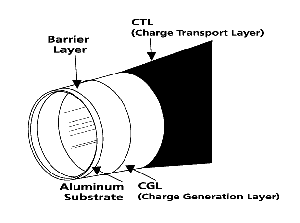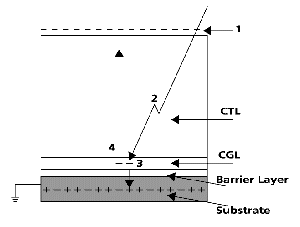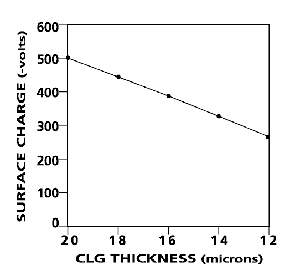This article provides both general and specific information to improve OPC care and use by a service technician/engineer. Following the guidelines presented here will reduce photoreceptor expenses and increase service department profits.
Brief OPC Explanation and History
The word “organic” in Organic PhotoConductor (OPC) means that a photoconductor is manufactured from organic (carbon-based) chemical compounds. These photoconductive compounds are actually petrochemical derivatives originating from the fossil fuels petroleum, natural gas, and coal.
In contrast obsolete cadmium sulfide, older selenium-based, and newer amorphous silicon photoconductor materials are manufactured from inorganic alloys or compounds. These photoconductive materials originate from purified, naturally occurring elements such as cadmium, sulfur, selenium, tellurium, arsenic, and silicon. All are actually inorganic photoconductors (IPCs), but the industry has historically classified and referred to them based on the photoconductive material used in their manufacture.
History
Kalle, A.G., a German firm, patented the first OPC formula in the late 1950s. Under license from Kalle, International Business Machines Corporation (IBM) introduced the first production OPC in their IBM Copier 1 in 1970. Over the next two decades, IBM, Xerox Corporation, and Eastman Kodak Company introduced their own internally developed and manufactured OPC formulas in numerous mid- and high- volume plain paper copiers. In fact, all current production Xerox and Kodak PPCs utilize OPCs. Although Sharp Electronics Corporation was not the first Japanese OEM to utilize an OPC, Sharp introduced the first successful line of Japanese low-volume copiers utilizing OPCs in the early 1980s.
In 1983, Canon, Inc. revolutionized OPC usage by introducing the OPC cartridge-based “personal copier” (PC) and subsequent laser printer (LP) engines. OPC production increased exponentially, primarily because of the phenomenal success of Canon PC and LP engines. By 1991, according to Dataquest, Inc., worldwide OPC production had exceeded 40 million units. Today the estimated number is 200 million units.
Fundamentals of OPC Materials
If a chemical compound contains carbon, it is often said to be an organic chemical compound. The term “organic” originally implied that these compounds were from once-living matter. Although chemists now know that carbon-containing compounds can be formed without once-living matter, the term “organic” remains in popular use.
Under the strict chemical definition, man-made goods such as herbicides, pesticides, chemical fertilizers, and plastics are classified as “organic” because they contain carbon compounds. However, in this age of environmental awareness, the term “organic” is often used to suggest positive aspects of a product. To most people, “organic” suggests that a product is “close to nature” and free from herbicides, pesticides, chemical fertilizers, and chemical preservatives and additives.
The contrast between the popular usage and the strict chemical definition of “organic” can create ambiguity: not all organic compounds are environmentally safe. OPCs are “organic” only in the strict sense that they are made from carbon-containing compounds. OPCs are environmentally safe for disposal, but only because designers/manufactures of these photoreceptors selected environmentally safe organic chemicals for raw materials.
Most OPCs are comprised of various plastics and organic pigments. Two-layer, negatively charged OPCs dominate today’s page printer and copier markets, so this technical bulletin concentrates on this system. The following explanation refers to the layer diagram shown in Figure 1.
Cross Section of OPC
Substrate:
The substrate layer (Figure 1) provides mechanical support and an electrical path to ground. Substrate form determines the physical shape (drum, belt, master) of an OPC. Japanese OEMs primarily utilize aluminum tube substrates for their OPCs, whereas Xerox and Kodak typically utilize flexible aluminized mylar belt substrates for their OPCs in both page printers and PPCs. Since the substrate serves as an electrode to the system, it must have a smooth surface that is both electrically and chemically correct. Most OPC manufactures “diamond turn” aluminum tube substrates to create a mirror-like surface. Canon, however, typically uses a conductive pigment layer (CPL) that acts both as a mask to cover substrate surface irregularities and as a barrier layer.

Barrier (or Blocking) Layer:
The barrier layer acts as an interface between the substrate and the photoconductive layers. Aluminum oxide and conductive pigments are two typical barrier layer materials.
The substrate and barrier layer are not active in the electrophotographic process, other than to facilitate photoconductivity physically and electronically. Because these two layers contribute only passively to the process, they are seldom included in OPC layer descriptions. If we had chosen to include them, we would refer to a four-layer OPC rather than to a two-layer OPC.
Charge Generation Layer (CGL):
The Charge Generation Layer (CGL) is referred to by many other names. We have chosen the common abbreviation “CGL” for use in this bulletin. It is important to have a basic understanding of the role of the CGL in determining OPC electrophotographic characteristics. The OPC generally takes its color from the CGL, and the color of the CGL depends on the specific organic chemical compounds it contains. However, color itself has no effect on OPC performance.
Machine design engineers select materials for the CGL based on photoresponse to a specific range of light, measured in nanometers. For a laser printer, photoresponse may be either in the visible range or in the infrared range, depending on the type of laser device used. In addition to determining spectral response, the CGL determines OPC sensitivity to light. The CGL layer is very thin: normal thickness ranges from 0.1 to 1 micron.
Charge Transport Layer (CTL):
For consistency, we refer to the Charge Transport Layer by its common abbreviation “CTL”. This layer is generally transparent, allowing light to pass through to the CGL. All OPC wear characteristics and charge acceptance values are determined by the CTL. Because the CTL surface contacts toner, developer, and paper, the CTL must be durable and resistant to abrasion. The CTL is typically about 20 microns thick. AS CTL technology improves, print yield (life) will increase. For further information on CTL life considerations, read the OPC Maintenance and Handling section on page 7.
Functional Explanation
Figure 2. OPC Functional Diagram-2-layer OPC
- .OPC surface receives uniform negative charge from corona or charge roller.
- Light energy from exposure passes through the CTL and into the CGL.
- Reaction from light energy creates free electrons in the CGL. These electrons migrate to the positively charged substrate.
- The resulting electron hole, a positive charge, moves through the CTL to neutralize (discharge) the surface in the exposed area.
Light Fatigue
All OPCs can be damaged when overexposed to light. The type and extent of the damage depends on the chemical composition of the specific OPC, the amount of time the OPC was exposed, and the type of light which it was subjected.
Temporary Damage From Visible Light:
In sufficient quantities, visible light causes OPC fatigue. After the OPC has been exposed, light prints (decreased charge acceptance) or heavy background may indicate visible-fatigue. Sometimes the OPC will gradually recover, depending on the time and intensity of exposure.
When OPC visible-light fatigue occurs, print quality is degraded. The technician/engineer has two options: wait until the OPC recovers, or replace the OPC. Each option costs money, so preventing light fatigue is worth the effort. Make sure to use light-protective sleeves (provided with most OPCs) during installation and service.
Permanent Damage From Ultraviolet (UV) Light:
The CTL allows visible and infrared light to pass through to the CGL. However, the CTL absorbs UV light, reducing charge transport performance. CTL damage causes higher voltages in discharged areas of the latent (undeveloped) image, resulting in reduced density and/or background on prints. Ultraviolet exposure from sunlight causes permanent, cumulative damage to OPC coatings.
Factors Affecting OPC Life
An OPC is much softer than a selenium-based photoreceptor, and will flex and rebound before chipping. Still, OPC is highly susceptible to damage from impact or mishandling. Excluding impact, mishandling, mechanical, or electrical damage, the two primary failure modes for page printer OPCs are mechanical wear and electrical deterioration. How long an OPC can last inside a given page printer model primarily depends on design-created environmental factors within the specific machine. The following sections present page printer design considerations as they relate to OPCs.
Mechanical Factors:
All OPCs eventually wear out. When the CTL coating wears thin, electrical charge acceptance diminishes and the OPC fails to produce prints with good resolution and contrast. Given that coating wear causes most OPC failures, it might seem that reducing OPC abrasion would be a top priority for page printer designers. However, printer engine designers often must design abrasion into the system to keep the OPC surface free of a film called “oxidation”.
Paper is also an important factor in OPC abrasion. Most OEMs recommend using high-quality, 16-24 lb. xerographic or bond paper stocks in page printers which utilize OPCs. These papers have smoother surfaces and contain fewer chemical contaminants, making them less abrasive to OPCs. The use of poor quality paper (recycled), paper stock, or label stock accelerates abrasion of an OPC surface and can cause premature failure. Adhesive chemical materials from label stock can also contaminate to OPC surface and create print quality problems.
Electrical Factors:
Charge acceptance and photosensitivity characteristics gradually change as an OPC wears. These changes are the results of mechanical wear, oxidation, and light fatigue or damage. As wear reduces the thickness of the CTL, the capability of the OPC to charge electrically is diminished (see figure 3). Some OEMs compensate by designing charge stability into the page printer. Common techniques include the incorporation of scorotron or grid charging systems. A controlled rate of OPC surface wear is required to reduce oxidation-related problems; OPCs could last longer if highly abrasive oxidation-removing components were not necessary. OEMs attempt to compensate for the expected electrophotographic change caused by OPC surface wear.
OPC wear rate depends on the wear coefficient of the CTL material, and on CTL interaction with toner, developer, and toner additives. Paper dust and other contaminants contribute to OPC wear, but not to the extent that the toner/OPC relationship does. Other than switching toner or OPC type, the technician/engineer cannot reduce OPC wear, beyond the reduction achieved by maintaining the page printer to OEM specifications.
Figure 3. Relationship of Charge Acceptance to CTL Thickness.
OPC Maintenance and Handling
Routine OPC maintenance will not significantly increase the life or reliability of an OPC. OPC surface are sensitive to contamination and to physical contact. Although Katun does not recommend cleaning OPCs, operator use of poor quality toner/developer or paper that causes OPC contamination may make cleaning necessary. Use extreme care, and follow the methods below. These OPC cleaning methods are listed in order of increasing severity (or probability of damaging the OPC). Any time an OPC coating is handled, the chance of damage is significant.
Method 1: Dry Chicopee Soft Cloth Lens Wipe
Chicopee Soft Cloths (Katun PN 707338) are inexpensive and readily available. Lightly wipe the affected surface area with even pressure. Be sensitive to any surface scratches caused by wiping.
Method 2: Dry Chicopee Soft Cloth Lens Wipe and Toner
Sprinkle a small amount of new, machine-specific toner on a clean, once-folded Chicopee Soft Cloth. Lightly wipe the area using the toner as both a lubricant and abrasive. Again, be sensitive to scratching the surface. Always begin with minimal wiping pressure and increase pressure only after inspecting for scratches. Change cloths frequently.
Method 3: Chicopee Soft Cloth Lens Wipe and Pure Distilled Water
Dampen the Chicopee Soft Cloth with a few drops of distilled water from a clean, sealed container. Lightly wipe the area with even pressure. Remove any residual moisture of film with a fresh Chicopee Soft Cloth.
Method 4: Chicopee Soft Cloth Lens Wipe Dampened 99% Isopropyl Alcohol
Follow Method 3, substituting a diluted Isopropyl Alchohol solution (Katun PN 703966) instead of the distilled water. Contact your Katun technican representative for further guidance. Alcohol, an organic solvent, can cause CTL damage. Use this method only as a last resort. Solvents such as trichloroethane or non-diluted alcohol should never be used for cleaning OPCs because they will cause permanent damage to the OPC coating.
There is no safe method to remove contamination from the surface of an OPC, so prevention should be stressed. Try to assure that your customers use quality toner, developer, and paper. Instruct service technicians/engineers to keep exhaust fans and ozone filters in good working condition, and to adhere to OEM-recommended ozone filter replacement intervals. Finally, please observe the following precautions when handling an OPC:
- When installing an OPC, wait until the last moment to remove the light-protective wrap.
- When removing the OPC from the machine during service, do not allow the OPC drum to be exposed to interior/outside light for an extended period of time. The OPC needs to be covered with light blocking material or placed in a dark location to prevent electrical damage to the coating.
- Do not allow any physical contact with the OPC coating.
- Use a blow brush or a Chicopee Soft Cloth, rather than blowing surface dust away with your breath. Saliva drops will cause spots on prints.
Aftermarket OPC Surface Treatments (Drum Coatings): Katun Strongly discourages the application of aftermarket surface treatments. Considering the precision required to produce an OPC product for a specific application, applying a foreign film to the CTL can only interfere with optimum OPC operation. Once the CTL is worn to the point where print quality becomes unacceptable, it can never be “replaced” by a surface treatment (drum coating).
The Replacement Alternative for Printer Technicians
Since a printer OPC drum typically is designed for an end-user replaceable cartridge, durability is not the designer’s primary concern. In developing a replacement OPC, however, Katun applies the most current, proven OPC technology to produce a long-life photoreceptor. Therefore, Katun offers state-of-the-art OPC formulations that often resist wear and oxidation significantly longer than the original OEM photoreceptor for a given page printer. Katun OPCs, developed and manufactured to be equal to or better than the comparable OEM products, provide a long-life, cost-saving alternative.

